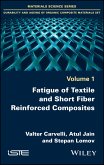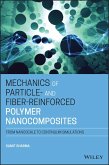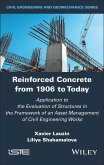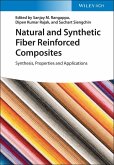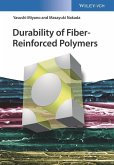Valter Carvelli, Atul Jain, Stepan Lomov
Fatigue of Textile and Short Fiber Reinforced Composites (eBook, ePUB)
139,99 €
139,99 €
inkl. MwSt.
Sofort per Download lieferbar

0 °P sammeln
139,99 €
Als Download kaufen

139,99 €
inkl. MwSt.
Sofort per Download lieferbar

0 °P sammeln
Jetzt verschenken
Alle Infos zum eBook verschenken
139,99 €
inkl. MwSt.
Sofort per Download lieferbar
Alle Infos zum eBook verschenken

0 °P sammeln
Valter Carvelli, Atul Jain, Stepan Lomov
Fatigue of Textile and Short Fiber Reinforced Composites (eBook, ePUB)
- Format: ePub
- Merkliste
- Auf die Merkliste
- Bewerten Bewerten
- Teilen
- Produkt teilen
- Produkterinnerung
- Produkterinnerung

Bitte loggen Sie sich zunächst in Ihr Kundenkonto ein oder registrieren Sie sich bei
bücher.de, um das eBook-Abo tolino select nutzen zu können.
Hier können Sie sich einloggen
Hier können Sie sich einloggen
Sie sind bereits eingeloggt. Klicken Sie auf 2. tolino select Abo, um fortzufahren.

Bitte loggen Sie sich zunächst in Ihr Kundenkonto ein oder registrieren Sie sich bei bücher.de, um das eBook-Abo tolino select nutzen zu können.
This book covers several aspects of the fatigue behavior of textile and short fiber reinforced composites. The first part is dedicated to 2D and 3D reinforced textile composites and includes a systematic description of the damage evolution for quasi-static and tensile-tensile fatigue loadings. Acoustic emissions and digital image correlation are considered in order to detect the damage modes initiation and development. The acoustic emission thresholds of the quasi-static loading are connected to the fatigue limit of the materials with distinctions for glass and carbon reinforcements.The second…mehr
- Geräte: eReader
- mit Kopierschutz
- eBook Hilfe
- Größe: 9.69MB
Andere Kunden interessierten sich auch für
![Fatigue of Textile and Short Fiber Reinforced Composites (eBook, PDF) Fatigue of Textile and Short Fiber Reinforced Composites (eBook, PDF)]() Valter CarvelliFatigue of Textile and Short Fiber Reinforced Composites (eBook, PDF)139,99 €
Valter CarvelliFatigue of Textile and Short Fiber Reinforced Composites (eBook, PDF)139,99 €![Mechanics of Particle- and Fiber-Reinforced Polymer Nanocomposites (eBook, ePUB) Mechanics of Particle- and Fiber-Reinforced Polymer Nanocomposites (eBook, ePUB)]() Sumit SharmaMechanics of Particle- and Fiber-Reinforced Polymer Nanocomposites (eBook, ePUB)152,99 €
Sumit SharmaMechanics of Particle- and Fiber-Reinforced Polymer Nanocomposites (eBook, ePUB)152,99 €![Reinforced Concrete from 1906 to Today (eBook, ePUB) Reinforced Concrete from 1906 to Today (eBook, ePUB)]() Xavier LauzinReinforced Concrete from 1906 to Today (eBook, ePUB)126,99 €
Xavier LauzinReinforced Concrete from 1906 to Today (eBook, ePUB)126,99 €![Natural and Synthetic Fiber Reinforced Composites (eBook, ePUB) Natural and Synthetic Fiber Reinforced Composites (eBook, ePUB)]() Natural and Synthetic Fiber Reinforced Composites (eBook, ePUB)144,99 €
Natural and Synthetic Fiber Reinforced Composites (eBook, ePUB)144,99 €![Natural Fiber-Reinforced Composites (eBook, ePUB) Natural Fiber-Reinforced Composites (eBook, ePUB)]() Natural Fiber-Reinforced Composites (eBook, ePUB)144,99 €
Natural Fiber-Reinforced Composites (eBook, ePUB)144,99 €![MXene Reinforced Polymer Composites (eBook, ePUB) MXene Reinforced Polymer Composites (eBook, ePUB)]() MXene Reinforced Polymer Composites (eBook, ePUB)173,99 €
MXene Reinforced Polymer Composites (eBook, ePUB)173,99 €![Durability of Fiber-Reinforced Polymers (eBook, ePUB) Durability of Fiber-Reinforced Polymers (eBook, ePUB)]() Yasushi MiyanoDurability of Fiber-Reinforced Polymers (eBook, ePUB)120,99 €
Yasushi MiyanoDurability of Fiber-Reinforced Polymers (eBook, ePUB)120,99 €-
-
-
This book covers several aspects of the fatigue behavior of textile and short fiber reinforced composites. The first part is dedicated to 2D and 3D reinforced textile composites and includes a systematic description of the damage evolution for quasi-static and tensile-tensile fatigue loadings. Acoustic emissions and digital image correlation are considered in order to detect the damage modes initiation and development. The acoustic emission thresholds of the quasi-static loading are connected to the fatigue limit of the materials with distinctions for glass and carbon reinforcements.The second part is devoted to the fatigue behavior of injection molded short fiber reinforced composites. Experimental evidence highlights the dependence of their fatigue response on various factors: fiber and matrix materials, fiber distribution, environmental and loading conditions are described. A hybrid (experimental/simulations) multi-scale method is presented, which drastically reduces the amount of experimental data necessary for reliable fatigue life predictions.
Dieser Download kann aus rechtlichen Gründen nur mit Rechnungsadresse in D ausgeliefert werden.
Produktdetails
- Produktdetails
- Verlag: John Wiley & Sons
- Erscheinungstermin: 10. März 2017
- Englisch
- ISBN-13: 9781119413455
- Artikelnr.: 52557390
- Verlag: John Wiley & Sons
- Erscheinungstermin: 10. März 2017
- Englisch
- ISBN-13: 9781119413455
- Artikelnr.: 52557390
- Herstellerkennzeichnung Die Herstellerinformationen sind derzeit nicht verfügbar.
Valter Carvelli has been Professor of Solid and Structural Mechanics at Politecnico di Milano in Italy since 2007. His main research activity is dedicated to the experimental measurement and numerical prediction of the mechanical properties of composites, with particular attention to the fatigue response.
Atul Jain currently teaches in the Department of Mechanical Engineering at the Indian Institute of Technology in Kharagpur. His interests lie in the intersection of manufacturing and mechanics of composites with a slight bias towards the latter.
Stepan Lomov is Professor in the Department of Materials Engineering at the University of Leuven (KU Leuven) in Belgium and coordinator of the Composite Materials Group. He is a specialist in the experimental and theoretical mechanics of composite materials and textiles.
Atul Jain currently teaches in the Department of Mechanical Engineering at the Indian Institute of Technology in Kharagpur. His interests lie in the intersection of manufacturing and mechanics of composites with a slight bias towards the latter.
Stepan Lomov is Professor in the Department of Materials Engineering at the University of Leuven (KU Leuven) in Belgium and coordinator of the Composite Materials Group. He is a specialist in the experimental and theoretical mechanics of composite materials and textiles.
Preface ix
Part 1 Fatigue of Textile Composites 1
Chapter 1 Fatigue Behavior and Damage Evolution of 2D and 3D
Textile-Reinforced Composites 3
1.1 Introduction 3
1.2 Experimental methodologies 5
1.3. Fatigue behavior and damage evolution in 2D E-glass plain weave
textile-reinforced epoxy composite 9
1.3.1 Quasi-static tensile behavior and damage observation 10
1.3.2 Fatigue life and damage metrics 15
1.3.3 Fatigue damage observation and evolution 18
1.3.4 Postfatigue mechanical properties and damage observation 21
1.4 Fatigue behavior and damage evolution in single-ply non-crimp 3D
orthogonal weave E-glass reinforced epoxy composite 24
1.4.1 Quasi-static tensile behavior and damage observation 26
1.4.2 Fatigue life and damage metrics 34
1.4.3 Fatigue damage observation and evolution 40
1.4.4 Postfatigue mechanical properties and damage observation 44
1.5 Fatigue behavior and damage evolution in 3D rotary braided carbon
reinforced epoxy composite 49
1.5.1 Quasi-static tensile behavior and damage observation 51
1.5.2 Fatigue life and damage metrics 55
1.5.3 Fatigue damage observation and evolution 58
1.5.4 Postfatigue mechanical properties 60
1.6 Fatigue behavior and damage evolution in non-crimp stitched and
unstitched carbon reinforced epoxy composite 63
1.6.1 Quasi-static tensile behavior 64
1.6.2 Fatigue life and damage metrics 67
1.6.3 Fatigue damage observation and evolution 71
1.6.4 Postfatigue mechanical properties 73
1.7 Remarks and perspectives 78
1.8 Bibliography 80
Chapter 2 Fatigue Limit: A Link to Quasi-Static Damage? 87
2.1 Fatigue limit 87
2.2 Damage development stages and load thresholds for quasi-static tension
90
2.3 Damage development in quasi-static tension and in the progression of
fatigue loading 93
2.4 Experimental data on the fatigue limit and the quasi-static damage
thresholds for textile composites 96
2.4.1 Fatigue limit for glass fiber reinforced composites 98
2.4.2 Fatigue limit for carbon fiber reinforced composites 100
2.5 Summary and conclusion on the fatigue life limit 102
2.6 Bibliography 104
Part 2 Fatigue of Short Fiber Reinforced Composites 107
Chapter 3 Experimental Observations of Fatigue of Short Fiber Reinforced
Composites 109
3.1 Injection molded SFRC 110
3.2 SN curve behavior of SFRC 113
3.2.1 Fiber-based parameters 115
3.2.2 Loading-based parameters 121
3.2.3 Environmental effects 123
3.2.4 Specimen configurations 125
3.3 Loss of stiffness 127
3.3.1 Collection of loss of stiffness data 131
3.3.2 Comparison of the loss of stiffness curves 133
3.4 Future outlook and modeling strategy 136
3.5 Bibliography 137
Chapter 4 Fatigue Modeling of SFRC: A Master SN Curve Approach 145
4.1 Overall framework and modeling strategy 145
4.2 Choice of a mean field homogenization method 151
4.2.1 Benchmarking of schemes with full FE solution 153
4.3 Damage modeling 157
4.3.1 Fiber-matrix debonding: equivalent bonded inclusion approach 159
4.3.2 Matrix damage 163
4.3.3 Validation 163
4.4 MSNC approach 165
4.4.1 Scaling of SN curves using the endurance limit 166
4.4.2 MSNC approach 168
4.4.3 Validation 173
4.4.4 Comparison of the MSNC scheme with other schemes 177
4.5 Component-level simulations 181
4.6 Conclusions and future outlook 184
4.7 Bibliography 185
Index 195
Part 1 Fatigue of Textile Composites 1
Chapter 1 Fatigue Behavior and Damage Evolution of 2D and 3D
Textile-Reinforced Composites 3
1.1 Introduction 3
1.2 Experimental methodologies 5
1.3. Fatigue behavior and damage evolution in 2D E-glass plain weave
textile-reinforced epoxy composite 9
1.3.1 Quasi-static tensile behavior and damage observation 10
1.3.2 Fatigue life and damage metrics 15
1.3.3 Fatigue damage observation and evolution 18
1.3.4 Postfatigue mechanical properties and damage observation 21
1.4 Fatigue behavior and damage evolution in single-ply non-crimp 3D
orthogonal weave E-glass reinforced epoxy composite 24
1.4.1 Quasi-static tensile behavior and damage observation 26
1.4.2 Fatigue life and damage metrics 34
1.4.3 Fatigue damage observation and evolution 40
1.4.4 Postfatigue mechanical properties and damage observation 44
1.5 Fatigue behavior and damage evolution in 3D rotary braided carbon
reinforced epoxy composite 49
1.5.1 Quasi-static tensile behavior and damage observation 51
1.5.2 Fatigue life and damage metrics 55
1.5.3 Fatigue damage observation and evolution 58
1.5.4 Postfatigue mechanical properties 60
1.6 Fatigue behavior and damage evolution in non-crimp stitched and
unstitched carbon reinforced epoxy composite 63
1.6.1 Quasi-static tensile behavior 64
1.6.2 Fatigue life and damage metrics 67
1.6.3 Fatigue damage observation and evolution 71
1.6.4 Postfatigue mechanical properties 73
1.7 Remarks and perspectives 78
1.8 Bibliography 80
Chapter 2 Fatigue Limit: A Link to Quasi-Static Damage? 87
2.1 Fatigue limit 87
2.2 Damage development stages and load thresholds for quasi-static tension
90
2.3 Damage development in quasi-static tension and in the progression of
fatigue loading 93
2.4 Experimental data on the fatigue limit and the quasi-static damage
thresholds for textile composites 96
2.4.1 Fatigue limit for glass fiber reinforced composites 98
2.4.2 Fatigue limit for carbon fiber reinforced composites 100
2.5 Summary and conclusion on the fatigue life limit 102
2.6 Bibliography 104
Part 2 Fatigue of Short Fiber Reinforced Composites 107
Chapter 3 Experimental Observations of Fatigue of Short Fiber Reinforced
Composites 109
3.1 Injection molded SFRC 110
3.2 SN curve behavior of SFRC 113
3.2.1 Fiber-based parameters 115
3.2.2 Loading-based parameters 121
3.2.3 Environmental effects 123
3.2.4 Specimen configurations 125
3.3 Loss of stiffness 127
3.3.1 Collection of loss of stiffness data 131
3.3.2 Comparison of the loss of stiffness curves 133
3.4 Future outlook and modeling strategy 136
3.5 Bibliography 137
Chapter 4 Fatigue Modeling of SFRC: A Master SN Curve Approach 145
4.1 Overall framework and modeling strategy 145
4.2 Choice of a mean field homogenization method 151
4.2.1 Benchmarking of schemes with full FE solution 153
4.3 Damage modeling 157
4.3.1 Fiber-matrix debonding: equivalent bonded inclusion approach 159
4.3.2 Matrix damage 163
4.3.3 Validation 163
4.4 MSNC approach 165
4.4.1 Scaling of SN curves using the endurance limit 166
4.4.2 MSNC approach 168
4.4.3 Validation 173
4.4.4 Comparison of the MSNC scheme with other schemes 177
4.5 Component-level simulations 181
4.6 Conclusions and future outlook 184
4.7 Bibliography 185
Index 195
Preface ix
Part 1 Fatigue of Textile Composites 1
Chapter 1 Fatigue Behavior and Damage Evolution of 2D and 3D
Textile-Reinforced Composites 3
1.1 Introduction 3
1.2 Experimental methodologies 5
1.3. Fatigue behavior and damage evolution in 2D E-glass plain weave
textile-reinforced epoxy composite 9
1.3.1 Quasi-static tensile behavior and damage observation 10
1.3.2 Fatigue life and damage metrics 15
1.3.3 Fatigue damage observation and evolution 18
1.3.4 Postfatigue mechanical properties and damage observation 21
1.4 Fatigue behavior and damage evolution in single-ply non-crimp 3D
orthogonal weave E-glass reinforced epoxy composite 24
1.4.1 Quasi-static tensile behavior and damage observation 26
1.4.2 Fatigue life and damage metrics 34
1.4.3 Fatigue damage observation and evolution 40
1.4.4 Postfatigue mechanical properties and damage observation 44
1.5 Fatigue behavior and damage evolution in 3D rotary braided carbon
reinforced epoxy composite 49
1.5.1 Quasi-static tensile behavior and damage observation 51
1.5.2 Fatigue life and damage metrics 55
1.5.3 Fatigue damage observation and evolution 58
1.5.4 Postfatigue mechanical properties 60
1.6 Fatigue behavior and damage evolution in non-crimp stitched and
unstitched carbon reinforced epoxy composite 63
1.6.1 Quasi-static tensile behavior 64
1.6.2 Fatigue life and damage metrics 67
1.6.3 Fatigue damage observation and evolution 71
1.6.4 Postfatigue mechanical properties 73
1.7 Remarks and perspectives 78
1.8 Bibliography 80
Chapter 2 Fatigue Limit: A Link to Quasi-Static Damage? 87
2.1 Fatigue limit 87
2.2 Damage development stages and load thresholds for quasi-static tension
90
2.3 Damage development in quasi-static tension and in the progression of
fatigue loading 93
2.4 Experimental data on the fatigue limit and the quasi-static damage
thresholds for textile composites 96
2.4.1 Fatigue limit for glass fiber reinforced composites 98
2.4.2 Fatigue limit for carbon fiber reinforced composites 100
2.5 Summary and conclusion on the fatigue life limit 102
2.6 Bibliography 104
Part 2 Fatigue of Short Fiber Reinforced Composites 107
Chapter 3 Experimental Observations of Fatigue of Short Fiber Reinforced
Composites 109
3.1 Injection molded SFRC 110
3.2 SN curve behavior of SFRC 113
3.2.1 Fiber-based parameters 115
3.2.2 Loading-based parameters 121
3.2.3 Environmental effects 123
3.2.4 Specimen configurations 125
3.3 Loss of stiffness 127
3.3.1 Collection of loss of stiffness data 131
3.3.2 Comparison of the loss of stiffness curves 133
3.4 Future outlook and modeling strategy 136
3.5 Bibliography 137
Chapter 4 Fatigue Modeling of SFRC: A Master SN Curve Approach 145
4.1 Overall framework and modeling strategy 145
4.2 Choice of a mean field homogenization method 151
4.2.1 Benchmarking of schemes with full FE solution 153
4.3 Damage modeling 157
4.3.1 Fiber-matrix debonding: equivalent bonded inclusion approach 159
4.3.2 Matrix damage 163
4.3.3 Validation 163
4.4 MSNC approach 165
4.4.1 Scaling of SN curves using the endurance limit 166
4.4.2 MSNC approach 168
4.4.3 Validation 173
4.4.4 Comparison of the MSNC scheme with other schemes 177
4.5 Component-level simulations 181
4.6 Conclusions and future outlook 184
4.7 Bibliography 185
Index 195
Part 1 Fatigue of Textile Composites 1
Chapter 1 Fatigue Behavior and Damage Evolution of 2D and 3D
Textile-Reinforced Composites 3
1.1 Introduction 3
1.2 Experimental methodologies 5
1.3. Fatigue behavior and damage evolution in 2D E-glass plain weave
textile-reinforced epoxy composite 9
1.3.1 Quasi-static tensile behavior and damage observation 10
1.3.2 Fatigue life and damage metrics 15
1.3.3 Fatigue damage observation and evolution 18
1.3.4 Postfatigue mechanical properties and damage observation 21
1.4 Fatigue behavior and damage evolution in single-ply non-crimp 3D
orthogonal weave E-glass reinforced epoxy composite 24
1.4.1 Quasi-static tensile behavior and damage observation 26
1.4.2 Fatigue life and damage metrics 34
1.4.3 Fatigue damage observation and evolution 40
1.4.4 Postfatigue mechanical properties and damage observation 44
1.5 Fatigue behavior and damage evolution in 3D rotary braided carbon
reinforced epoxy composite 49
1.5.1 Quasi-static tensile behavior and damage observation 51
1.5.2 Fatigue life and damage metrics 55
1.5.3 Fatigue damage observation and evolution 58
1.5.4 Postfatigue mechanical properties 60
1.6 Fatigue behavior and damage evolution in non-crimp stitched and
unstitched carbon reinforced epoxy composite 63
1.6.1 Quasi-static tensile behavior 64
1.6.2 Fatigue life and damage metrics 67
1.6.3 Fatigue damage observation and evolution 71
1.6.4 Postfatigue mechanical properties 73
1.7 Remarks and perspectives 78
1.8 Bibliography 80
Chapter 2 Fatigue Limit: A Link to Quasi-Static Damage? 87
2.1 Fatigue limit 87
2.2 Damage development stages and load thresholds for quasi-static tension
90
2.3 Damage development in quasi-static tension and in the progression of
fatigue loading 93
2.4 Experimental data on the fatigue limit and the quasi-static damage
thresholds for textile composites 96
2.4.1 Fatigue limit for glass fiber reinforced composites 98
2.4.2 Fatigue limit for carbon fiber reinforced composites 100
2.5 Summary and conclusion on the fatigue life limit 102
2.6 Bibliography 104
Part 2 Fatigue of Short Fiber Reinforced Composites 107
Chapter 3 Experimental Observations of Fatigue of Short Fiber Reinforced
Composites 109
3.1 Injection molded SFRC 110
3.2 SN curve behavior of SFRC 113
3.2.1 Fiber-based parameters 115
3.2.2 Loading-based parameters 121
3.2.3 Environmental effects 123
3.2.4 Specimen configurations 125
3.3 Loss of stiffness 127
3.3.1 Collection of loss of stiffness data 131
3.3.2 Comparison of the loss of stiffness curves 133
3.4 Future outlook and modeling strategy 136
3.5 Bibliography 137
Chapter 4 Fatigue Modeling of SFRC: A Master SN Curve Approach 145
4.1 Overall framework and modeling strategy 145
4.2 Choice of a mean field homogenization method 151
4.2.1 Benchmarking of schemes with full FE solution 153
4.3 Damage modeling 157
4.3.1 Fiber-matrix debonding: equivalent bonded inclusion approach 159
4.3.2 Matrix damage 163
4.3.3 Validation 163
4.4 MSNC approach 165
4.4.1 Scaling of SN curves using the endurance limit 166
4.4.2 MSNC approach 168
4.4.3 Validation 173
4.4.4 Comparison of the MSNC scheme with other schemes 177
4.5 Component-level simulations 181
4.6 Conclusions and future outlook 184
4.7 Bibliography 185
Index 195

